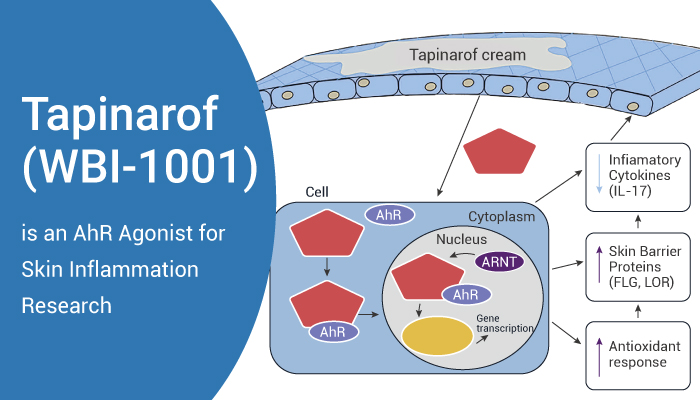Aryl Hydrocarbon Receptor (AhR or AHR) is a cytoplasmic receptor and transcription factor that belongs to the family of basic helix-loop-helix transcription factors. The AhR is activated or inhibited by various types of exogenous and endogenous ligands. Meanwhile, the different structures and properties of AhR ligands mean that when they combine with AhR they have distinct biological effects. Upon ligand binding in the cytoplasm, the activated AhR-ligand complex heterodimerizes with the AhR nuclear translocator (ARNT), resulting in transformation of the complex into a high-affinity DNA-binding transcription factor. AhR is a ligand-dependent transcription factor that regulates gene expression in a range of cells, including immune and epithelial cells. Moreover, AhR is widely expressed in immune cells, including antigen-presenting cells, T cells, fibroblasts, macrophages, mast cells, and other skin immune cells.

Tapinarof (also known as WBI-1001, Benvitimod or GSK2894512) is a first-in-class natural AhR agonist.
Tapinarof shows anti-inflammatory and antioxidant properties. In addition, Tapinarof has the potential for psoriasis and atopic dermatitis research. In psoriasis, Tapinarof specifically binds and activates AhR, leading to the downregulation of pro-inflammatory cytokines, including IL-17, and modulating the expression of skin barrier proteins to promote skin barrier normalization. Besides, Tapinarof binds and activates AhR in multiple cell types, including cells of the target tissue-human skin. Moreover, AhR signaling regulates gene expression in immune cells and skin cells and has critical roles in the regulation of skin homeostasis.
In AhR-sufficient mice, Tapinarof leads to compound-driven reductions in erythema, epidermal thickening, and tissue cytokine levels. However, Tapinarof has no impact on imiquimod-induced skin inflammation in AhR-deficient mice. In all, the anti-inflammatory properties of Tapinarof derive from AhR agonism.
To sum up, Tapinarof is a first-in-class AhR agonist with anti-inflammatory properties.
References:
[1] Susan H Smith, et al. J Invest Dermatol. 2017 Oct;137(10):2110-2119.
[2] Robert Bissonnette, et al. J Am Acad Dermatol. 2021 Apr;84(4):1059-1067.